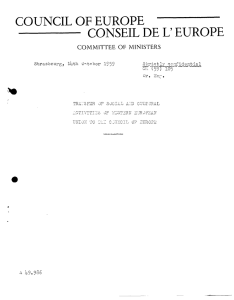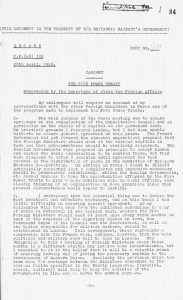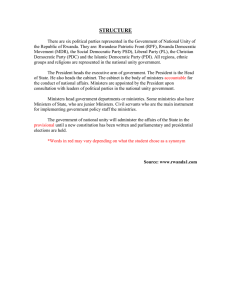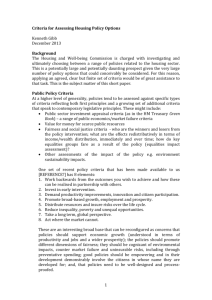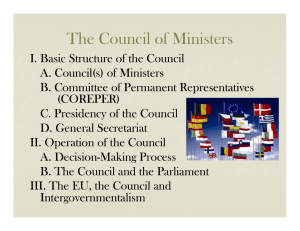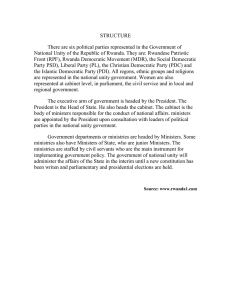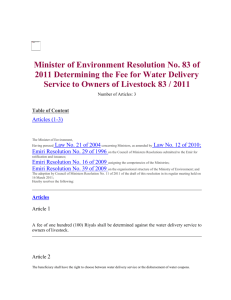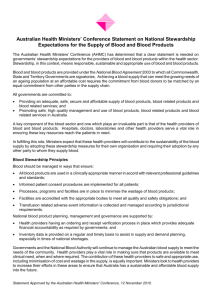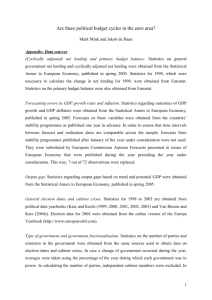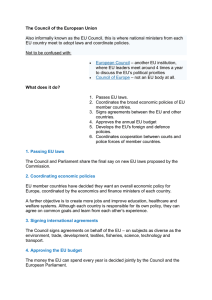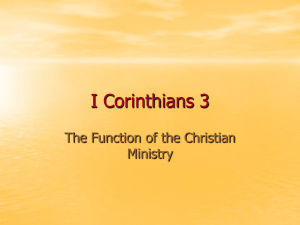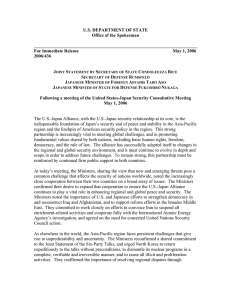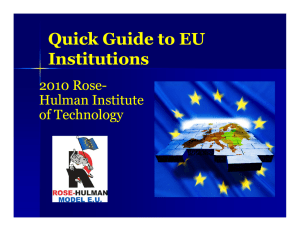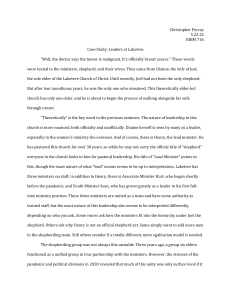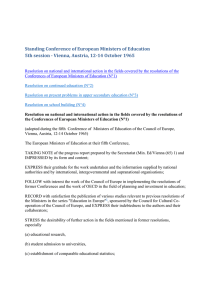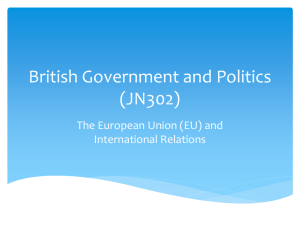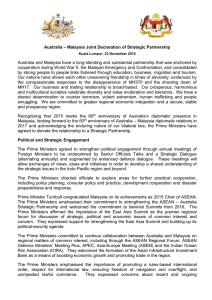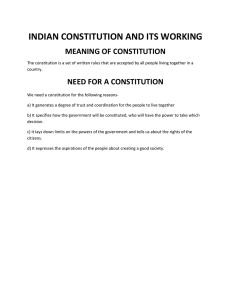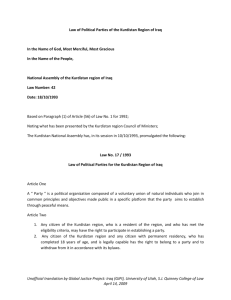EU Reading
advertisement
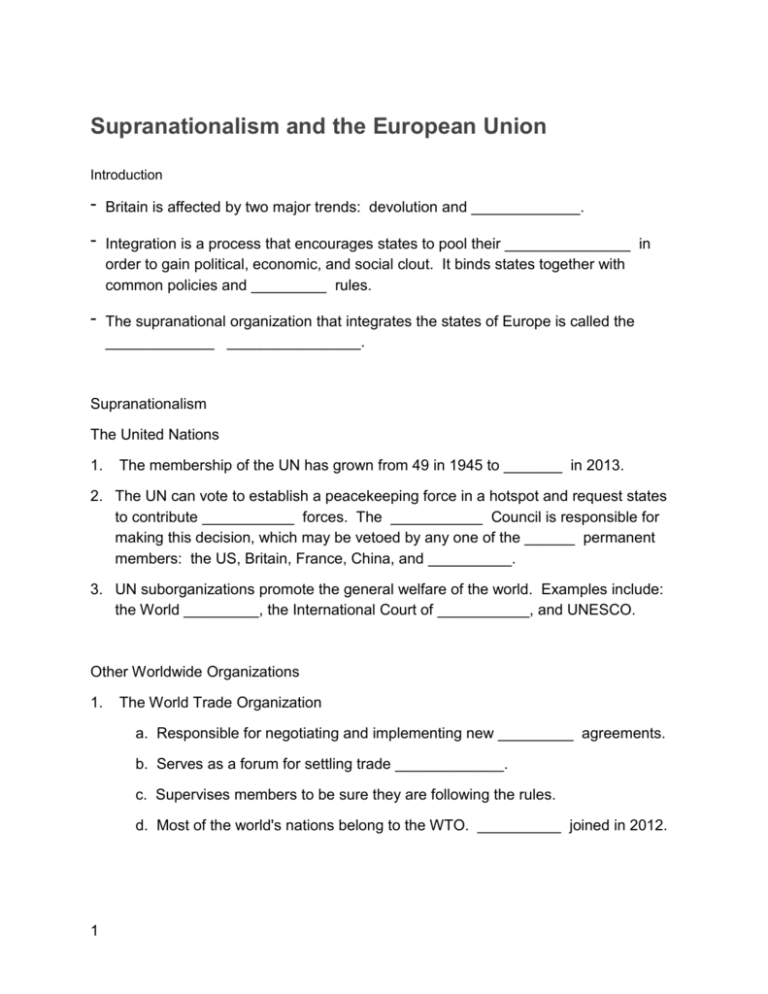
Supranationalism and the European Union Introduction - Britain is affected by two major trends: devolution and _____________. - Integration is a process that encourages states to pool their _______________ in order to gain political, economic, and social clout. It binds states together with common policies and _________ rules. - The supranational organization that integrates the states of Europe is called the _____________ ________________. Supranationalism The United Nations 1. The membership of the UN has grown from 49 in 1945 to _______ in 2013. 2. The UN can vote to establish a peacekeeping force in a hotspot and request states to contribute ___________ forces. The ___________ Council is responsible for making this decision, which may be vetoed by any one of the ______ permanent members: the US, Britain, France, China, and __________. 3. UN suborganizations promote the general welfare of the world. Examples include: the World _________, the International Court of ___________, and UNESCO. Other Worldwide Organizations 1. The World Trade Organization a. Responsible for negotiating and implementing new _________ agreements. b. Serves as a forum for settling trade _____________. c. Supervises members to be sure they are following the rules. d. Most of the world's nations belong to the WTO. __________ joined in 2012. 1 2. The World Bank a. Focus today is on loaning money to low and middle income countries at modest interest rates. The Bank wants to eliminate ___________ in these countries. b. Strong criticism of the Bank has focused on the way in which it is ____________ Regional Organizations 1. Give two examples of regional military alliances. 2. What is the OAS? 3. What is the Arab League? 4. What is the OAU? The European Union A Brief History 1. Review the predecessors to the EU. Anything that you find interesting or unusual? 2. Which treaty created the modern EU? What are the three pillars or spheres of authority? Membership 1. As of 2013, there are ______ countries. Which country was last admitted? 2. Why is the possible admission of Turkey controversial? 3. In order to be accepted for membership, candidate nations must provide evidence to meet three important criteria. What are they? Organization 2 1. The EU is composed of four major bodies: the Commission, the Council of Ministers, the European Court of Justice, and the European ___________________. 2. The Commission a. headed by a president b. has ______ members, one from each member state of the EU, supported by a _______________ of several thousand European civil servants. 3. each Commissioner takes responsibility for a particular area of _________ and heads a department called a Directorate General. 3. The Council of Ministers a. The Council demonstrates the continuing power of the __________. b. The Council consists of _______ ministers, finance ministers, the president of ___________, and all the prime ministers of the other members. c. The heads of state meet every six months as the ___________ Council. d. The president of the Council has a 2 1/2 year term. e. Each country is assigned a number of votes in proportion to its share of _______________. 4. The European Parliament a. Directly elected by the ___________ every ______ years. b. May propose ____________ to legislation, and it may reject proposals from Council outright. Council may ___________ a rejection by a unanimous vote. c. Apportionment of representatives is not strictly based on __________. Smaller states have disproportionately greater representation. 5. The European Court of Justice 3 a. Supreme Court of the European Union, and it has the power of judicial ____________. Its decisions may limit national _____________. b. Give one example of how the ECJ has limited national sovereignty. c. There are _______ judges. Cases are decided by a simple majority. 6. Policymaking Power. Briefly explain each of these areas in which the EU has taken over policymaking from their member states: a. Creating and maintaining a single internal market b. Union of monetary policy c. Common agricultural policy 7. The European Constitution a. Which two countries rejected the European Constitution? b. What was the consequence of this rejection? c. Name three provisions of the Lisbon Treaty. d. What does the author mean by the term "democratic deficit?" 8. Economic Issues a. The European Union has been defined by a tension between economic liberalism and economic _________________. b. Briefly explain the sovereign debt crisis. 4
